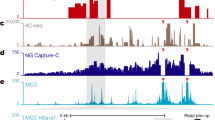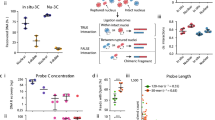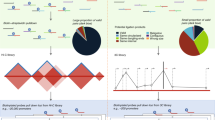Abstract
Transcription regulation in higher eukaryotes is controlled by regulatory elements such as enhancers that are recognized by transcription factors. In many cases regulatory elements can be located at distances up to several megabases from their target genes1,2. Recent evidence shows that long-range control of gene expression can be mediated through direct physical interactions between genes and these regulatory elements. Such looping interactions can be detected using the chromosome conformation capture (3C) methodology3. Although 3C is experimentally straightforward, to draw meaningful conclusions one must carefully design 3C experiments and implement the conscientious use of controls. The general guidelines presented here should help experimental design and minimize misinterpretation of 3C experiments.
This is a preview of subscription content, access via your institution
Access options
Subscribe to this journal
Receive 12 print issues and online access
$259.00 per year
only $21.58 per issue
Buy this article
- Purchase on Springer Link
- Instant access to full article PDF
Prices may be subject to local taxes which are calculated during checkout


Similar content being viewed by others
References
Kleinjan, D.A. & van Heyningen, V. Long-range control of gene expression: emerging mechanisms and disruption in disease. Am. J. Hum. Genet. 76, 8–32 (2005).
West, A.G. & Fraser, P. Remote control of gene transcription. Hum. Mol. Genet. 14, R101–R111 (2005).
Dekker, J., Rippe, K., Dekker, M. & Kleckner, N. Capturing chromosome conformation. Science 295, 1306–1311 (2002).
Spilianakis, C.G., Lalioti, M.D., Town, T., Lee, G.R. & Flavell, R.A. Interchromosomal associations between alternatively expressed loci. Nature 435, 637–645 (2005).
Tolhuis, B., Palstra, R.J., Splinter, E., Grosveld, F. & de Laat, W. Looping and interaction between hypersensitive sites in the active β-globin locus. Mol. Cell 10, 1453–1465 (2002).
Osborne, C.S. et al. Active genes dynamically colocalize to shared sites of ongoing transcription. Nat. Genet. 36, 1065–1071 (2004).
Spilianakis, C.G. & Flavell, R.A. Long-range intrachromosomal interactions in the T helper type 2 cytokine locus. Nat. Immunol. 5, 1017–1027 (2004).
Vakoc, C. et al. Proximity among distant regulatory elements at the β-globin locus requires GATA-1 and FOG-1. Mol. Cell 17, 453–462 (2005).
Dekker, J. A closer look at long-range chromosomal interactions. Trends Biochem. Sci. 28, 277–280 (2003).
Splinter, E., Grosveld, F. & de Laat, W. 3C technology: analyzing the spatial organization of genomic loci in vivo. Methods Enzymol. 375, 493–507 (2004).
Miele, A., Gheldof, N., Tabuchi, T.M., Dostie, J. & Dekker, J. Mapping chromatin interactions by chromosome conformation capture (3C). In Current Protocols in Molecular Biology (eds. Ausubel, F.M. et al.) Supplement 74 (John Wiley & Sons, Hoboken, in the press).
Palstra, R.J. et al. The β-globin nuclear compartment in development and erythroid differentiation. Nat. Genet. 35, 190–194 (2003).
Drissen, R. et al. The active spatial organization of the β-globin locus requires the transcription factor EKLF. Genes Dev. 18, 2485–2490 (2004).
Rippe, K. Making contacts on a nucleic acid polymer. Trends Biochem. Sci. 26, 733–740 (2001).
Liu, Z. & Garrard, W.T. Long-range interactions between three transcriptional enhancers, active Vkappa gene promoters, and a 3′ boundary sequence spanning 46 kilobases. Mol. Cell. Biol. 25, 3220–3231 (2005).
Murrell, A., Heeson, S. & Reik, W. Interaction between differentially methylated regions partitions the imprinted genes Igf2 and H19 into parent-specific chromatin loops. Nat. Genet. 36, 889–893 (2004).
ENCODE Project Consortium. The ENCODE (ENCyclopedia Of DNA Elements) Project. Science 306, 636–640 (2004).
Acknowledgements
I acknowledge members of the Dekker lab, M. Walhout and J. Perry, for discussions and critical reading of the manuscript. Research in the Dekker lab is supported by a grant from the National Institutes of Health (HG03143).
Author information
Authors and Affiliations
Corresponding author
Ethics declarations
Competing interests
The author declares no competing financial interests.
Rights and permissions
About this article
Cite this article
Dekker, J. The three 'C' s of chromosome conformation capture: controls, controls, controls. Nat Methods 3, 17–21 (2006). https://doi.org/10.1038/nmeth823
Published:
Issue Date:
DOI: https://doi.org/10.1038/nmeth823
This article is cited by
-
Insulator-based loops mediate the spreading of H3K27me3 over distant micro-domains repressing euchromatin genes
Genome Biology (2020)
-
The chromosome-scale assembly of the willow genome provides insight into Salicaceae genome evolution
Horticulture Research (2020)
-
Assembly of allele-aware, chromosomal-scale autopolyploid genomes based on Hi-C data
Nature Plants (2019)
-
Changes in long-range rDNA-genomic interactions associate with altered RNA polymerase II gene programs during malignant transformation
Communications Biology (2019)
-
3C-PCR: a novel proximity ligation-based approach to phase chromosomal rearrangement breakpoints with distal allelic variants
Human Genetics (2018)



